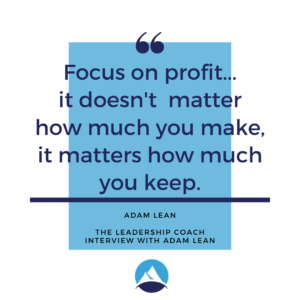Six Steps for Making Decisions in the Face of Uncertainty


All climbers face fear. Whether summiting a peak, climbing a rock wall or ascending a frozen waterfall there is always the reality that the higher you are, the further you can fall.
The best and safest climbers have a healthy relationship with this fear. They feel it; yet, it doesn’t control them.
It’s dangerous to go to extremes: Climbers who don’t feel fear take unnecessary risks with their own safety and the safety of others. Climbers who are controlled by fear, ironically, tend to create even more risk and danger for themselves and others.
Being a leader is like being a climber. The way we relate to fear impacts how safely, and effectively, we can lead.
When we talk about risky leadership, we tend to think of leaders who make reckless, reactive or irresponsible decisions.
As dangerous as those decisions can be, it can sometimes be worse to make no decision at all.
Many leaders are paralyzed in decision-making due to fears of failure, not being sure of what the right answer is or making an unpopular or controversial decision.
What do leaders fear?
In my experience leaders mostly fear the following:
- The unknown
- Failure or error
- Conflict
- Embarrassment or rejection
Impact of fear
Classically, fear generates the fight, freeze or flight responses in people. That’s true for leaders as well.
These responses, presumably, are helpful when attacked by a bear but not in decision making. However, having grown up in bear country, I can tell you that they aren’t that helpful with bear encounters either.
It’s always better to keep your head.
Fear makes it difficult for leaders to make decisions or commit resources.
Fear causes people to believe that agreements don’t exist. Leaders and followers often see things similarly – but leaders are afraid that this isn’t true. This is a common challenge in leading change.
Fear of the unknown causes people to react to decisions, judgments or circumstances that exist only in their speculation or hypothesis.
Fear causes actually causes many of the problems we seek to avoid – From poorer decisions to misplaced priorities, to over or underreactions, to ineffective communication and conflict.
What can a leader do to make decisions, despite fear?
1. Revisit your values and vision.
Your values provide a framework for decision making. Assuming you have done good work in identifying them, they’ll serve you well in decision making.
What options best live into or reflect your values? Which options violate your values?
You can similarly use your vision. Even in a crisis, your vision should function as a guide.
What options move your closer to your vision? Which options move you further away?
2. Pursue sound and current data.
Most “data” or information comes from the media, gossip or anecdotes. It is rare that decisions are made from reliable, tested sources of information that haven’t gone stale.
In many client relationships, what I’m first told about the situation rarely reflects actual reality. It’s not, usually, that I’m being lied to. It’s that many leaders shortcut the work of finding good data, instead of relying on interpretation, assumptions and trusted but biased advisors.
Invest in gathering good information. How this is done depends on the issue at hand. But it is critical to stay grounded in reliable, objective sources of information.
Along with this, minimize your exposure to sensational or unreliable information. It just serves to stir up anxiety and “contaminate” your perspective.
3. Develop an objective way to make decisions.
A proven way to simplify decision-making is to decide on the decision making criteria in advance. There are many approaches for doing this. Two ways that I have often used when mediating disputes or facilitating decision making are:
Get agreement on the process: I was conducting a feasibility study and strategic planning process for a private-public partnership. We ran into questions and controversy about the community’s desire for a set of services and the appropriateness of the partnership.
That question could’ve been debated forever and there were some who wanted to do that. Instead, we adopted a process for answering the question: I would conduct focus groups within the community. The community members’ responses and stated preferences would serve as our answer.
This ended the debate and allowed us to continue with what eventually became a highly successful and popular program.
We based our decision on the results of an agreed-upon process.
Agree on the priorities: Continuing the example above, our second step was to identify the underlying concerns or desires of all the major players or key stakeholders. There are many tools for doing this. Sometimes just gathering them all in a list and identifying commonalities is sufficient. Other times, ranking priorities or weighting each item on the list is beneficial.
In this instance, I facilitated stakeholder meetings when we identified the priorities or interests of each group. We found, as is typical, that most people agree (or at least don’t disagree) at the level of interests. Typically they disagree on methods.
We based our decisions on alignment with shared priorities.
However you go about it, developing an objective process for decision-making saves an enormous amount of time and emotional energy while providing what a leader needs to make confident decisions.
4. Explain the “Why?” and the Value.
Many leaders experience resistance; not because of their decision, but instead because their decision wasn’t explained or not explained well. These leaders make the mistake of either explaining nothing or explaining, at length, the wrong thing (often the story of how the decision was made.) The problem is: most people don’t care how the decision was made.
People are interested in how they, and those they care about, will benefit (or at least not be harmed) by a decision.
It’s like a commuter asking an engineer about a bridge. The engineer wants to talk about design challenges. The driver just wants to know where the bridge begins and ends and whether it will shorten the trip.
If leaders take the time to explain why a decision was made and outline the benefits, most people are satisfied. Don’t answer questions no one is asking.
5. Create the future.
Leaders are at the front of the trail, hacking their way through the jungle, trying to make good decisions about direction.
Others follow along the trail thinking whatever they are thinking about the quality of the trail, its direction, the leader’s speed, etc.
Their experience is not the leader’s experience.
It’s not leadership to only make decisions in a completely known, safe environment. That’s management.
Good management is important. However, when facing the unknown, leadership is necessary.
The best leaders don’t try to guess the right future. They create the right future.
Leaders have to be willing to gather the best information they can, develop a process for making decisions, communicate the “why” and the value of their decisions and then act.
6. Adjust as needed
Leadership is an essay, not a math test. You have room to improve your answer as you go. There are very few leadership decisions that can’t be reversed, amended or somehow adjusted.
Make the best decision you can. Relentlessly execute. Assess results. Adjust as needed.
Rinse and repeat.
Is there a decision that you’ve been putting off? What will you do next?
Take good care,
Christian
Are you curious about the value of your company? Try my free tool: The Value Builder System
The Value Builder System™ is a 13-minute online questionnaire that evaluates your business on the eight factors that contribute more to its attractiveness and value. These factors are scored on a scale of 1-100. Businesses that score over 80 are likely to command 70%-100% higher value than others. Click here to learn more or get your free Value Builder Score.
Would you like my help for yourself, your team or board to get a clear vision of 2020? Don’t leave it to chance. Give me a call 907-522-7200 or e-mail me.
In my podcast, THE LEADERSHIP COACH, we explore effective, high impact and enjoyable leadership. We talk about personal development and the attributes that all effective leaders possess. I interview other leadership experts who share their knowledge and tips to help you build the confidence to lead and learn the habits of good decision-making.
Opportunities
Did someone send you this article? You can receive it, free, directly from me each week. Click here to sign up. You can unsubscribe at any time. I won’t feel too hurt.
Free Resource: How To Accomplish More Without Doing More is a workbook I created to walk leaders through a process of helping you own your calendar, liberate your time, and still get more done. Download it for free!
Executive and Leadership Coaching: Do you feel overwhelmed? Are you not getting the results you expect from the effort you are putting in? Do you find yourself facing similar challenges time and time again? Would you like to change specific ways of relating or reacting? If you would like to experience predictable, measurable growth Contact me.
Profitable Exit Strategy Workshop: Are you a business owner or partner? Are you over 55? Are you starting to think about exiting your business or active management in the next 3-5 years?
- Are you curious about what your business might be worth?
- Would you like to discover the specific steps you need to take to increase its value and become highly attractive to a buyer?
- Are you planning on handing it over to family or employees and you want to ensure long-term success?
If so, contact me now
Article Categories
Popular articles

Download my free 10-page eBook:
How To Accomplish More Without Doing More:
Eight Proven Strategies To Change Your Life
Discover how to save eight hours during your workweek-even if you're too busy to even think about it. The resource every maxed out executive needs.
